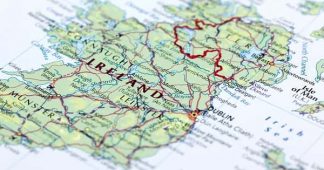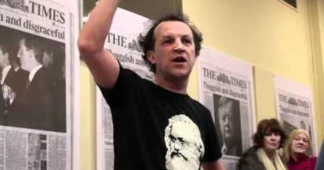With Adam Bandt as leader, the Australian Greens are charting a leftward course and developing the country’s most ambitious policy proposals. The next step is to build a strong movement behind it — and to achieve that, it will need a democratically empowered membership.
By Abraham O’Neill
05.02.2020
While Australia has so far escaped runaway coronavirus infections, the crisis has pushed millions more into poverty and housing insecurity. Excluded from the JobKeeper scheme, millions of casual and migrant workers are particularly vulnerable.
Just as the pandemic-era conditions began to demand radical change, the Greens’ new federal leader Adam Bandt, a former union lawyer from Melbourne, started to redefine the party. His flagship policy is a Green New Deal, articulated along similar lines to those in the United States and the UK, which aims to address the crises of work, inequality, and the climate at the same time.
This signals broader changes in the party. On April 13, Greens members began voting in a party-wide ballot to democratize the federal leadership. If successful, this move could help revitalize party democracy, draw in new members, and build the kind of active mass party that can give a meaningful Green New Deal a fighting chance.
Democratizing the Party
The party-wide ballot now underway asks Greens members how leaders should be elected. They are given three options.
The first is to keep the status quo, a top-down model whereby the leader is chosen by the party’s federal parliamentary group. While the Greens do not have a formalized faction system like the Australian Labor Party (ALP), members quip that if formal factions did exist, the biggest and best organized would be the Party Room. In a largely volunteer-run party without affiliated union bureaucracies, the leader and their twenty-two paid staff are already incredibly powerful. Choosing the status quo would leave power concentrated in their hands, largely disempowering members.
The second option is to adopt an ALP-style system, in which the leadership vote is split fifty-fifty between party members and the Party Room. In practice, this would mean that one MP, in addition to their existing advantages, would have a vote equal to approximately 1,500 party members. This could easily lead to a situation like that faced by the ALP in 2013. Labor MPs chose the right-aligned Bill Shorten in a factional stitch-up, overriding their own members who voted for Anthony Albanese, nominally of the party’s Left. Throughout his six years as leader Shorten remained chronically unpopular with voters.
The third option is a more democratic one. If a leadership candidate can win support from 20 percent of the Party Room, they are put on the ballot. From there, a leader is elected on the basis of “one member, one vote” (OMOV), providing a degree of control to the party’s base hitherto unknown in any major left-wing Australian political party.
The campaign for OMOV is, as a recently published open letter shows, beginning to create a counterweight to the hitherto dominant and politically timid leadership. Some influential Greens figures support change, but it’s already obvious that a more transformative vision for the Greens’ future does not appeal to some of the party’s establishment, including Richard Di Natale, Bob Brown, Christine Milne, and other sitting MPs who have campaigned to maintain the status quo.
Like previous leaders, Bandt came to power in a closed-door meeting of MPs. Unlike Di Natale, who stalled progress for years, Bandt has previously supported democratization. Recently, however, he has equivocated, apparently backing the second, ALP-style system.
The only way to push toward and secure his Green New Deal is to give thousands of regular people a direct, meaningful say over the party’s direction. If the Greens want to lead a recovery from the pandemic, the party must democratize.
Growing Tensions
The Australian Greens are generally to the left of their sister parties around the world. Even so, until Adam Bandt, they had never had a leader from the party’s Left.
Under the moderate leadership of Bandt’s predecessor, Richard Di Natale, the party remained stuck at 10 percent of the primary vote. Di Natale, an urbane doctor in a three-piece suit, won the leadership in May 2015 with the support of former leader Christine Milne. Upon taking the helm, he immediately signaled the moderate direction the party would take under his “progressive mainstream” leadership.
On several occasions, this brought the Greens close to disaster. Only a month after Di Natale’s selection, the Greens voted with the Coalition to further means-test the Age Pension, a savings measure that further undermined the already heavily means-tested welfare system. The financial press heaped on the praise, but Di Natale’s new direction failed to impress voters. In the July 2016 federal election, three of nine Senators nearly lost their seats.
Later, Di Natale scored an own goal in an attempt to distance the party from “Left Renewal,” a socialist grouping in the Greens. He referred to flag burning by First Nations activists as an act of violence. He went on to declare the Greens “do not support the overthrow of capitalism or any other ridiculous notions of the sort” and invited anticapitalists to leave the party.
The Greens came closest to disaster in June 2017, when the Party Room debated whether to support the Coalition’s school funding reforms (called “Gonski 2.0”). Gonski 2.0 favored wealthier private schools and locked in funding shortfalls for the poorest public schools. For weeks, the leadership inched toward a deal with the government. The conservative press and centrist think tanks supported the package, while the teachers’ unions and the ALP vigorously opposed it.
New South Wales Greens senator Lee Rhiannon and many on the party’s member-elected National Council recognized that a deal would be badly discrediting with the party’s base, and held out. Eventually, the package passed without the Greens’ votes, although it included significant concessions which they had secured.
Following this, in a five-hour meeting, every MP except Bandt voted to “suspend” Rhiannon from the Party Room. The suspension backfired, building significant support for Rhiannon in the NSW Greens and accelerated the push for party democracy. It was quietly reversed.
At the same time, evidence was mounting that a left platform could succeed. The Greens’ Queensland branch won some unexpected victories — its first local government and state parliamentary seats in 2016 and 2017, respectively. The platform was bold: $1 public transport fares, universal public housing, free childcare, extra public holidays, and publicly owned renewables, funded by higher taxes on big corporations. Both victories relied on an unprecedented organizing effort, with volunteers knocking on sixty thousand doors statewide. In New South Wales, left-wing members prevailed in an upper house preselection, and the party managed to hold its seats in the 2019 state election, despite moderates leading a failed attempt to split.
Meanwhile, other state branches, under more moderate leadership, fared much worse. At the 2018 state election, the Tasmanian Greens’ vote fell to its lowest level in nearly thirty years. That same year, the Victorian Greens unexpectedly lost a federal by-election in the seat of Batman. The 2018 Victorian State election claimed four of seven sitting MPs. Following one last disappointing performance in the 2019 federal election, the Party Room saw that a change in direction was needed: they handed Adam Bandt the leadership. His strident left leadership has created an unprecedented opportunity to democratize party processes.
A New Deal for the Greens?
Since becoming the parliamentary leader, Bandt has begun to redefine the party, placing a Green New Deal front and center. Crucially, he has linked the solutions to the climate crisis with a bold but concrete plan to improve living standards, for example, proposing to expand lithium mining, and hydrogen exports to provide employment for coal miners as fossil fuel industries are wound down. This platform recognizes coal’s deep embeddedness in the Australian political economy while refusing to allow the Greens to be presented as anti-worker.
Bandt’s Green New Deal has also knitted together existing Greens policies like free education, dental care and childcare, boosting unemployment benefits, publicly owned clean energy, and zero-carbon industrial exports.
Still, we’ll need to go further. The United Workers’ Union’s plan, which demands Medicare and a visa amnesty for migrant workers, a moratorium on rent and mortgage payments, and a basic income alongside a jobs guarantee is a good start. A first step in that direction would be to make the temporary increase to the JobSeeker unemployment payment permanent and to make the Youth Allowance and the Age Pension available to everyone under twenty-five and over sixtyf-ve.
The Coalition’s “JobKeeper” wage subsidy should certainly be expanded to cover all workers regardless of visa status, but it must ultimately be replaced with a democratically controlled public sector job guarantee. It could create well-paid, unionized work at four days per week, delivering social services and restoring the land. This could be funded by socializing the finance sector and democratizing Australia’s superannuation system, which ties workers’ retirement savings to the stock market and costs them $34 billion per year in fees. Underlying this program must be a commitment to an Indigenous “Blak New Deal”, including a right of veto over mining projects.
It will take more than electoral success to defend and impose a Green New Deal — it will require a confrontation with fossil capital. A confrontation demands a mass membership, supported by strong, working-class organizing. But none of this will be possible without an active and engaged membership that has a real say over the Greens’ direction.
One member, one vote is about democracy — but it’s also about more than democracy. OMOV is about building a movement that can fight for our future











